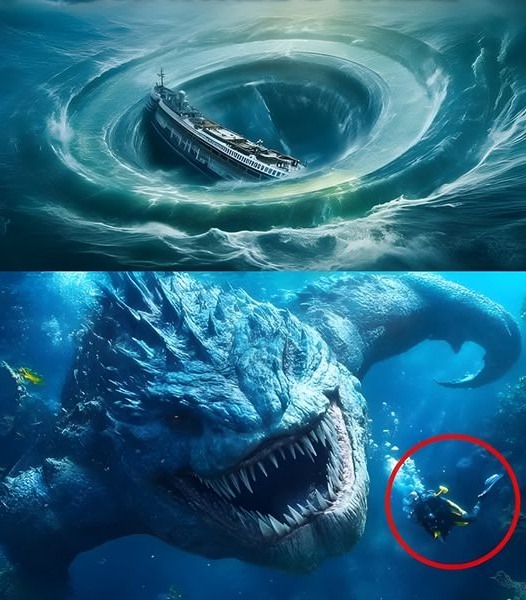Megalodon Resurfaces? Terror Strikes the Bermuda Triangle

The ocean has always been a realm of mystery, but recent reports have sent shockwaves through the scientific community and the public alike: sightings and sonar readings suggest that the colossal Megalodon—a prehistoric shark believed extinct for millions of years—might still roam the depths of the Bermuda Triangle. This chilling possibility merges paleontology, maritime legend, and the enduring mystique of one of the world’s most enigmatic regions.
The Megalodon: Ocean’s Ancient Predator

Megalodon, scientifically known as Carcharocles megalodon, was the largest shark to have ever lived, with estimates suggesting lengths of up to 60 feet (18 meters) or more. Its enormous jaws and rows of serrated teeth made it an apex predator, dominating the prehistoric oceans. Fossil evidence indicates it thrived millions of years ago, preying on whales and other large marine animals. While mainstream science asserts that the species went extinct around 2.6 million years ago, tales of Megalodon sightings persist, fueling speculation about hidden populations in uncharted oceanic trenches.
The Bermuda Triangle Connection
The Bermuda Triangle, stretching between Florida, Bermuda, and Puerto Rico, has long been synonymous with maritime mysteries. Ships and planes are said to vanish inexplicably in this area, and while many incidents have rational explanations—storms, navigation errors, and magnetic anomalies—the region’s reputation as a locus of strange phenomena endures.
Reports of unusually large sonar contacts and unexplained underwater disturbances have recently reignited speculation that a living Megalodon could inhabit the deep waters of the Triangle. The area’s remote trenches, extreme depths, and minimal human activity create an ideal, unexplored habitat for such a massive predator, if it exists.

Scientists and Skeptics
Despite the excitement, scientists urge caution. Many sonar anomalies can be attributed to whales, underwater currents, or geological formations. Skeptics argue that the Megalodon’s survival for millions of years without leaving clear fossil or ecological evidence is highly improbable. Yet, the mystery persists because the ocean remains largely unexplored, particularly in regions as deep and remote as the Bermuda Triangle.
Marine biologists emphasize that while Megalodon’s continued existence is unlikely, the excitement underscores humanity’s fascination with apex predators and the unknown. The notion of an ancient shark surviving in isolation captures the imagination and highlights how legends and science often intersect in the human desire to explain the unexplainable.
Cultural Impact and Fear
The idea of a Megalodon lurking in the Bermuda Triangle has permeated popular culture, inspiring documentaries, films, and novels. Tales of vanishing ships gain new weight when paired with prehistoric horror, blending fact and fiction in ways that captivate the public. Fear, curiosity, and the awe-inspiring power of nature combine to make the Megalodon a symbol of the ocean’s ultimate mysteries.
Conclusion
While definitive evidence of a living Megalodon remains elusive, the reports from the Bermuda Triangle revive one of the ocean’s most terrifying and fascinating legends. Whether myth or reality, the idea of a prehistoric predator surviving in uncharted waters reminds us that the oceans are still full of secrets—some beautiful, some deadly. As researchers continue to explore the deep, the Megalodon mystery reinforces humanity’s enduring fascination with the unknown and the primal fear that the ocean still holds creatures beyond our imagination.










